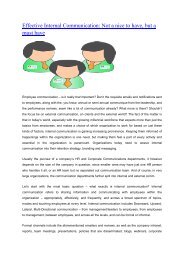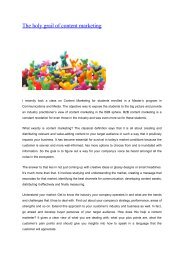Leveraging User Communities to Create Deep Business Impact
User communities, per se, are not a new phenomenon. They have existed in the real world for years, but in more passive forms. Wherever there are products, there are users, and inevitably users would get together to discuss their experiences with the product. Housewives deriding the local grocer, students comparing the attributes of their pens, and even office-goers arguing over the usability of a particular brand of laptop are all user communities in their most basic form.
User communities, per se, are not a new phenomenon. They have existed in the real world for years, but in more passive forms.
Wherever there are products, there are users, and inevitably users would get together to discuss their experiences with the
product. Housewives deriding the local grocer, students comparing the attributes of their pens, and even office-goers arguing
over the usability of a particular brand of laptop are all user communities in their most basic form.
You also want an ePaper? Increase the reach of your titles
YUMPU automatically turns print PDFs into web optimized ePapers that Google loves.
Another potential pitfall is that of malicious hacking. As exemplified by the Propellerhead case, user communities may become<br />
hubs for hacking and other subversive activity. Although, Propellerhead’s was a case in which this proved beneficial, there exists<br />
a threat of malicious ‘modding’ also which hurts products and users alike.<br />
Providing detailed company information on networking sites can compromise a company’s privacy, in addition <strong>to</strong> being a security<br />
risk. In the case of firm-hosted communities, unsanctioned use of Web 2.0 technologies by employees is a very relevant threat.<br />
These and many other potential security risks must be kept in mind by companies when they are mapping out their Web 2.0<br />
strategies.<br />
Companies typically choose <strong>to</strong> handle the latter by creating specific policies for use and enabling access only <strong>to</strong> certain cus<strong>to</strong>mer<br />
facing employees. In a sense this is no different from a call center transaction.<br />
Prayag’s Take<br />
Looking for solutions rather than “dumping the baby with the bathwater” is the approach that’s needed here since any use of<br />
the Web 2.0 <strong>to</strong>ols can best be described as explora<strong>to</strong>ry. And the benefits and rewards are compelling reasons <strong>to</strong> choose this<br />
path as there is plenty that Indian enterprises and, specifically, IT companies could leverage. Keeping in mind the large number<br />
of players in the Indian IT vendor space, competition is fierce. Cus<strong>to</strong>mer service has become a key differentiating fac<strong>to</strong>r for<br />
sustaining growth and it is here that user communities can score – either as product support forums or knowledge centers or<br />
even cus<strong>to</strong>mer user communities. Given that technology is the raison d’etre for the Indian IT industry, it would also be a case of<br />
walking the talk.<br />
For more information on this <strong>to</strong>pic and <strong>to</strong> read similar articles, visit our website www.prayag.com.<br />
Prayag Consulting<br />
45/B, 2 nd Floor, Front Wing, 1 st Main,<br />
J P Nagar, 3 rd Phase, Bangalore - 560078<br />
Ph: (91) 80 26593328 /41200439<br />
Fax: (91) 80 2659 3327<br />
info@prayag.com<br />
www.prayag.com


















